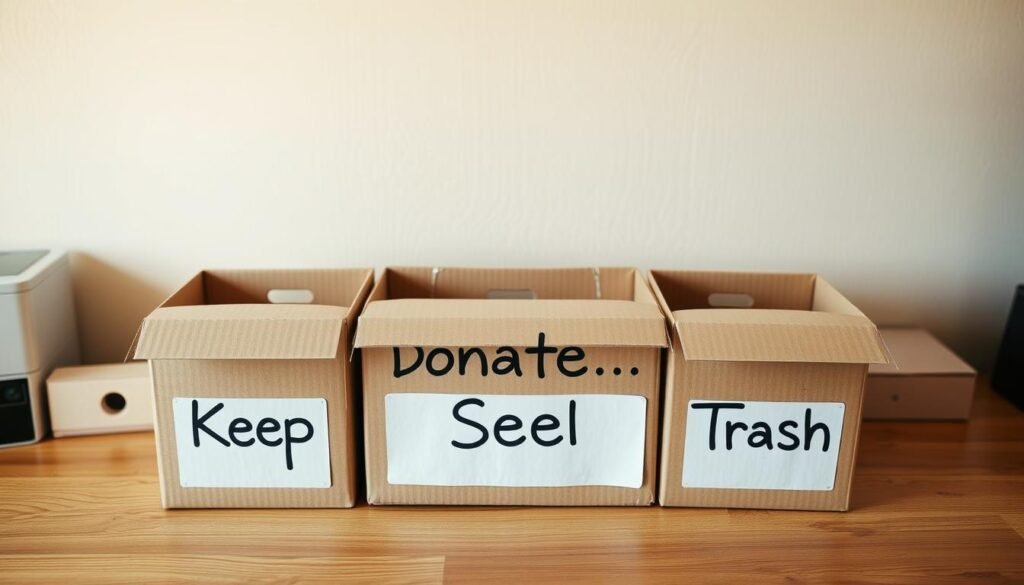Table of Contents
Feeling overwhelmed by clutter at home? You’re not alone. Many struggle with keeping their spaces tidy, but there’s a simple solution gaining traction. The 4-box decluttering method offers a stress-free way to tackle mess without overcomplicating things.
Unlike complex systems, this approach focuses on quick decisions. Just sort items into four categories: keep, donate, trash, or relocate. No endless pondering—just clear, fast progress. Good Housekeeping editors even used it to transform a bedroom in just 15 minutes!
This technique works for any space—apartments, houses, or storage areas. Social media buzz proves its effectiveness, with countless success stories from real users. Say goodbye to stress and hello to a cleaner, more organized home.
What Is the 4-Box Decluttering Method?
Struggling to decide what stays and what goes in your home? This system cuts through the noise. It’s built on four clear categories: Keep, Trash, Donate, and Storage. No more “maybe piles” that linger for weeks.

A Simple System for Quick Decisions
Professional organizer Chas Greener notes:
“Limiting options prevents perfectionism paralysis.”
Here’s how it works:
- Keep: Daily essentials or loved possessions (e.g., coffee maker, favorite sweater).
- Trash: Broken or expired items (cracked dishes, old magazines).
- Donate: Gently used things others need (extra blankets, duplicate kitchen tools).
- Storage: Seasonal or sentimental pieces (holiday decor, childhood memorabilia).
Storage expert Alyssa Gautieri recommends wicker bins for better visibility. “Cardboard boxes hide contents, leading to forgotten items,” she says.
| Traditional Sorting | Four-Category Method |
|---|---|
| Multiple “maybe” piles | Forces quick decisions |
| Time-consuming | 15-minute room resets |
| Works for some spaces | Adapts to any space |
Why This Method Works for Any Space
From studio apartments to garages, the categories stay the same. Cinch Storage reports clients organize 40% faster with this approach. Tip: If you’re undecided, default to Storage or Donate.
It’s not about perfection—it’s about progress. Start small (a drawer) or tackle a whole room. The choice is yours.
How to Set Up Your 4-Box Decluttering System
Ready to transform your space but unsure where to start? The right containers and labels turn chaos into clarity. Here’s how to build a system that works.

Choosing Your Boxes (or Bins)
Collapsible bins beat cardboard for durability. Amazon’s bestselling storage bins stack neatly and last for years. For quick projects, recycled shipping boxes work too—just reinforce the bottoms.
Cinch Storage suggests sizes based on room type:
- 18″x18″: Ideal for clothing or books.
- 24″x12″: Fits kitchen gadgets or shoes.
Pro tip: Repurpose laundry baskets for bulky items like blankets. Color-code bins (red for trash, green for donate) to speed up sorting.
Labeling Strategies for Clarity
Permanent markers outlast sticky notes, which peel off. The Simple Joy Show adds a fifth “relocate” box for misplaced items—no more wandering with stray objects.
Avoid “label drift” with these fixes:
- Use a label maker for multi-day projects.
- Write on masking tape for easy updates.
Storage expert Alyssa Gautieri warns:
“Unlabeled bins become black holes for clutter.”
Step-by-Step Guide to the 4-Box Method
Decluttering doesn’t have to be hard. Follow these easy steps for a cleaner space. Whether you’re tackling a closet or a garage, this system keeps decisions simple.

The “Keep” Box: Items You Use and Love
Ask yourself: “Have I used this in the past year?” If yes, it belongs in the keep box. This includes:
- Daily essentials like coffee makers or work bags.
- Sentimental favorites (limit to one memory box).
Professional organizers recommend a 20% max rule for storage. The rest should earn its place.
The “Trash” Box: What to Let Go Of
Some things just need to go. Throw away these surprises:
- Expired medications or cosmetics.
- Tangled cables and broken chargers.
Decluttering coach Hayley Forster suggests a 5-minute timer per pile. Quick choices prevent overthinking.
The “Donate” Box: Giving Items a Second Life
*Donate* gently used clothes to Dress for Success or books to local libraries. Goodwill reports each donation creates job training opportunities.
Charity shops look for:
- Clean, stain-free clothing.
- Working electronics with cords.
The “Storage” Box: Seasonal or Sentimental Items
Use storage sparingly for holiday decor or childhood memorabilia. Label bins clearly to avoid “storage creep.”
“Review stored items quarterly—if unopened, it’s time to donate.”
Room-by-Room Decluttering Tips
Different rooms need different approaches to stay organized. What works for your cooking space won’t necessarily help your sleeping area. These targeted strategies make every corner of your home easier to manage.

Tackling the Kitchen (Without Overwhelm)
Start with one drawer or cabinet at a time. The “appliance graveyard” (that collection of single-use gadgets) often needs the most attention. Ask: “Would I buy this potato ricer again today?”
Quick kitchen fixes:
- Group similar items together (baking supplies, lunch containers)
- Store daily-use items at eye level
- Donate duplicate tools to community kitchens
Simplifying Bedrooms and Wardrobes
Clothing piles up fast. Try the 4-year rule: If you haven’t worn it in four seasons, let it go. Store off-season things in underbed bins—they’re perfect for bulky sweaters or summer gear.
Bedroom must-dos:
- Clear nightstands of non-sleep related items
- Rotate decorative pillows seasonally
- Keep a donation bag in your closet
Living Spaces: Shared Family Areas
Common areas collect the most clutter. Cinch Storage suggests making it a team effort—set a 10-minute family tidy-up time daily. Designate spots for remotes, magazines, and toys to prevent surface buildup.
For your living space:
- Use attractive baskets for quick clean-ups
- Create a “returns” bin for misplaced objects
- Limit decorative items to one shelf or table
Overcoming Common Decluttering Challenges
Hitting roadblocks while organizing is normal—here’s how to push through. Even the best systems face emotional hurdles and decision fatigue. These proven strategies keep your progress on track.

Dealing with Sentimental Items
That childhood trophy or wedding favor holds sentimental value, not practical use. Cinch Storage suggests asking: “Does this memory need the physical object?” Try these alternatives:
- Photograph items before donating
- Keep one representative piece (e.g., single baby outfit)
- Create a digital memory book
Professional organizer Marla Stone advises:
“Sentiment isn’t in the thing—it’s in the story. Write down why it matters, then let go.”
What to Do When You’re Stuck
If the process feels overwhelming, use this 3-question filter:
- Have I used this in the past 90 days?
- Would I buy it again today?
- Does it serve my current lifestyle?
Two “no” answers mean it’s time to part ways. For tough calls, Simple Joy Show recommends a 30-day trial separation box.
Avoiding the “Maybe Pile” Trap
That growing maybe pile becomes tomorrow’s clutter. First Source warns against lingering boxes—they collect dust, not decisions. Try these instead:
| Problem | Solution | Timeframe |
|---|---|---|
| Undecided about clothes | Backward hanger test | 3 months |
| Unused hobby supplies | Rent storage locker | 6-month contract |
| Gift guilt items | Regift within 1 year | Holiday cycle |
Still struggling? Recruit a clutter buddy—someone neutral who asks: “When did you last wear this?” Sometimes, we just need permission to let go.